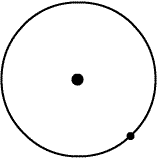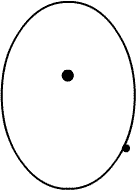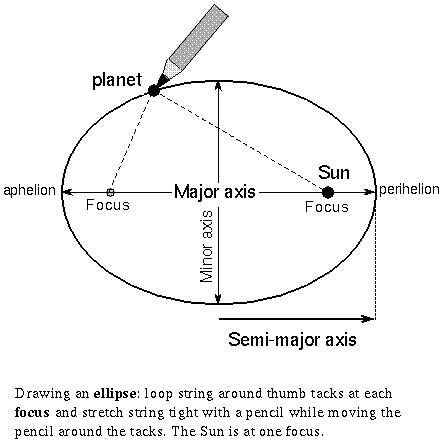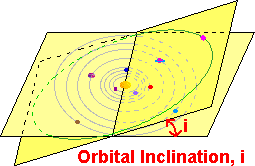

|
| Circular Orbit |

|
| Elliptical Orbit |
Pictures of the Solar System tend to show all the orbits of the planets as circles centered on the Sun (see image at left). The big object in the center of the circle represents the Sun. The smaller object on the circle represents a planet. Notice that the Sun is exactly in the center of the orbit. No orbit in the solar system is perfectly round.
In reality, the planets orbit the Sun travelling along an oval path (see image at right). The mathematical term for this shape is an ellipse. This ellipse is a little more stretched out than real planetary orbits but it has been exaggerated on purpose to demonstrate the shape more clearly. Notice that the Sun in this picture is not right in the center. The Sun is at one of the two ‘centers’ of the ellipse. These are called foci (plural for focus). The closer these foci are together, the more circular the orbit. The orbit of Venus is the closest to a circle of any planet in the Solar System. Scientists have a name to describe just how much like an ellipse an orbit is. This is called eccentricity and is a measure that uses numbers between 0 and 1. If an orbit has an eccentricity close to 1 then the ellipse is so long as to be more cigar-shaped than round. Comets tend to have very elongated, high-eccentricity orbits. The closer the eccentricity is to zero, the more circular the orbit.

In the image at right you can see some of the vocabulary words you need in order to understand ellipses. The ellipse itself is the big oval shape. It has two axes: a major axis (the longer axis) and a minor axis (the shorter one). It has two foci: in the case of planetary orbits one focus is the Sun. All the points in an ellipse are defined in relation to the foci. The sum of the distances from each point on the ellipse to both foci is constant for all points on the ellipse. The point on an orbit nearest the Sun is called perihelion. The point farthest from the Sun is called aphelion.
Eccentricity is a measure of how round or elongated an ellipse is. It is calculated by dividing the distance between the foci by the length of the major axis.
One other unrelated thing you should know is that the planets are not all on the same plane. Imagine the Solar System as a giant disk defined by the Earth’s orbit. All of the planets’ orbits are sometimes above this disk and sometimes below it. Astronomers say that the orbits of the planets have different inclinations relative to Earth’s orbit. The ecliptic is the astronomer’s word for this giant disk. In our sky we see the disk as a line that circles the Earth. It can also be understood as the apparent path of the Sun through the sky as the Earth orbits it. Because the planets are usually above or below this disk we call the ecliptic they appear above and below the line of the ecliptic in the sky.

This experiment will demonstrate the relationship between the distance between the foci of an ellipse, the length of the major axis, and the eccentricity of the ellipse. You will learn how planets really move in their orbits. You will speculate on what life would be like on a planet with a very elliptical orbit and on whether life would even be possible there.

| Data Table | ||||
|
Planet
|
Distance Around
Orbit Loop |
Distance Between Sun Pin and Second Pin | Length of Major Axis | Eccentricity |
| Björn | 7.3 cm | 1.3 cm | ||
| Morton | 10.7 cm | 2.7 cm | ||
| Helga | 12.6 cm | 0.6 cm | ||
| Daisy | 17.3 cm | 2.3 cm | ||
| Karl | 35.0 cm | 15.0 cm | ||
| Name | Eccentricity |
Planetary Year
(days) |
Rotation Period
(days) |
Mean Orbital Velocity
(km/s) |
|---|---|---|---|---|
| Venus | 0.0068 | 224.701 | 243.0187 | 35.02 |
| Neptune | 0.0097 | 60190.00 | 0.67125 | 5.44 |
| Earth | 0.0167 | 365.256 | 0.99727 | 29.79 |
| Uranus | 0.0461 | 30685.00 | 0.71833 | 6.80 |
| Jupiter | 0.0483 | 4332.71 | 0.41354 | 13.06 |
| Moon | 0.05 | 27.32166 | 27.32166 | 1.02 |
| Saturn | 0.0560 | 10759.50 | 0.44401 | 9.66 |
| Mars | 0.0934 | 686.98 | 1.025957 | 24.13 |
| Mercury | 0.2056 | 87.969 | 58.6462 | 47.87 |
| Pluto | 0.2482 | 90800 | 6.3872 | 4.74 |
In the table above you will find data about the planets in our Solar System. They are in order by their eccentricities. Compare the values you found for the experimental eccentricites to the values of the planets in our Solar System. Use this data and the data you collected to create a graph. Graph paper has been provided. Along the bottom write the names of the planets, including the made-up planets. Space them equally on the long axis of the graph paper. Along the left side make a scale for the eccentricity. It should range from 0 to 1. You will make a simple bar graph that helps you to see the differences in the value of the eccentricity for different planets. Use the graph of the data you collected to help you answer the following questions.
Use your imagination to answer these questions. Imagine that the Earth had a much higher eccentricity (say around 0.40). At some times of the year we would be very close to the Sun and at other time we would be very far away. Perihelion and aphelion would be at very different distances from the Sun. An important fact is that the farther from the Sun a planet is, the slower it moves. This means that we would be in the cold far-from-the-Sun part of the orbit longer than in the hot close-to-the-Sun part of the orbit.
Comets have orbits with very high eccentricities. They originate in a zone far beyond the orbit of Pluto know as the Kuiper Belt. It is very like the Asteroid Belt found between the orbits of Mars and Jupiter. Kuiper Belt object are typically made of water ice, ammonia, methane and a little rock and metal. They are essentially dirty snowballs. Occasionally a passing star or other disturbance causes some of these objects to be accelerated toward the Sun. Since they originate from so far away their orbits are very elongated. Halley’s Comet (due to return to view on Earth in 2061) has an orbital eccentricity of 0.9673. Its orbit is inclined 163° to the ecliptic. The orbital period is 76 years.